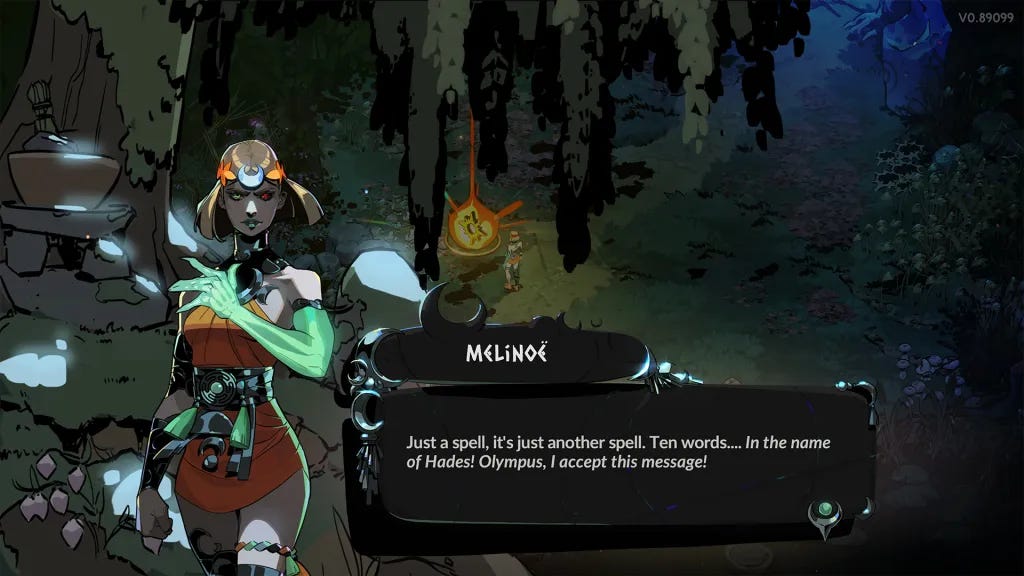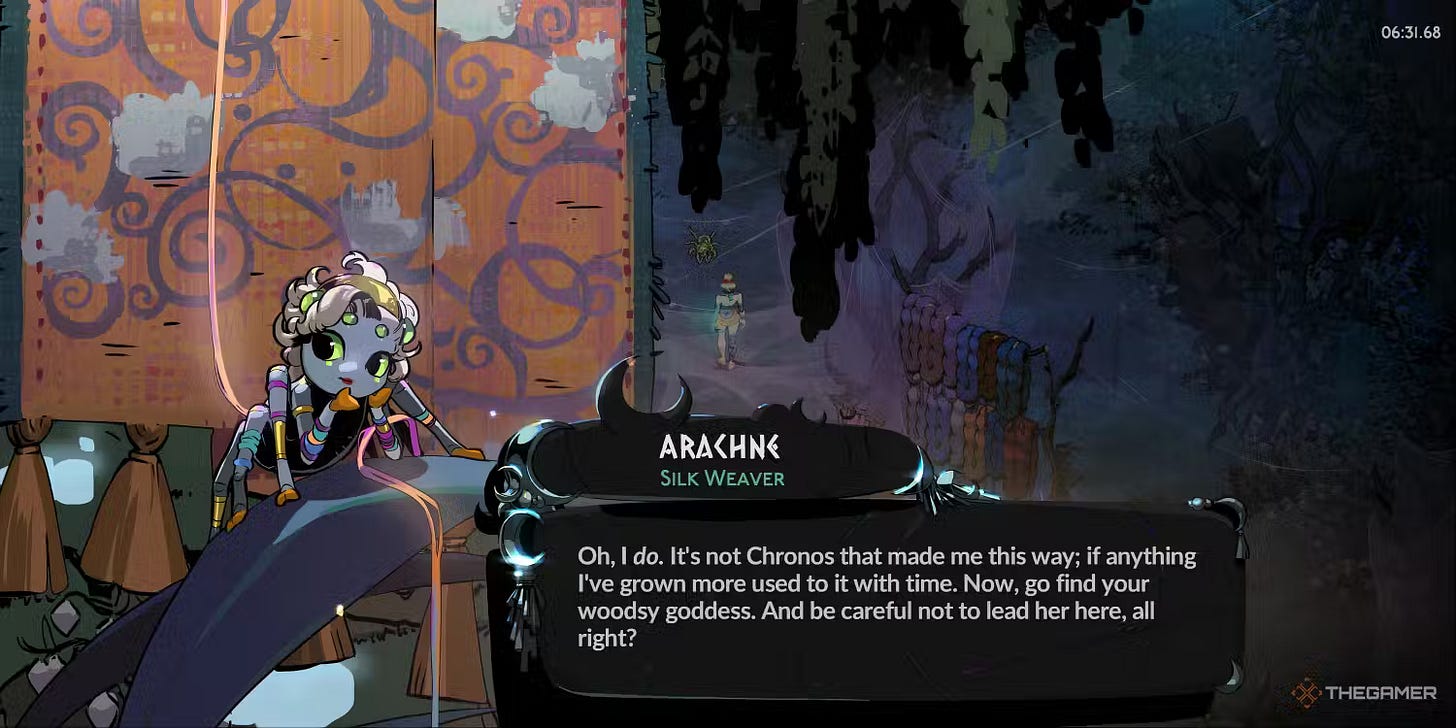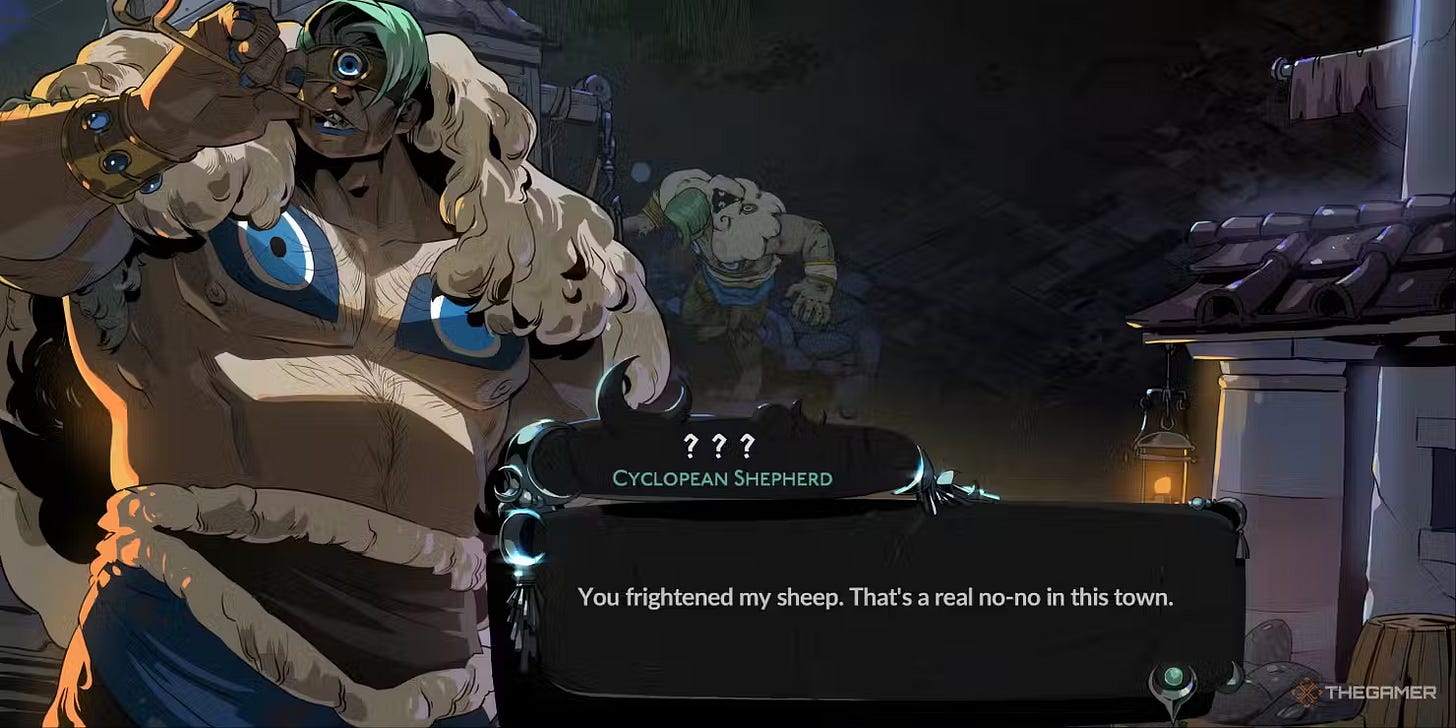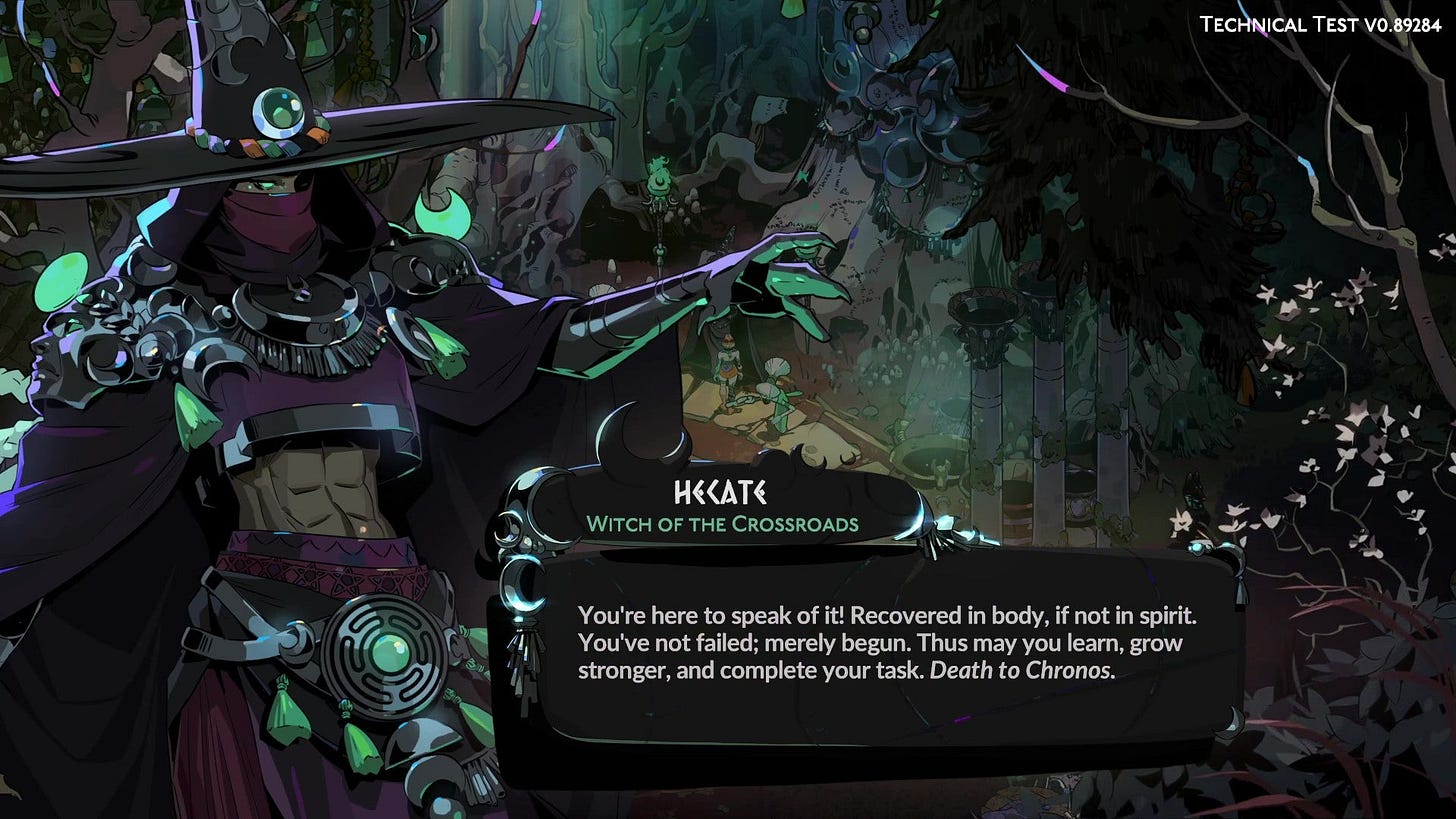Early Access Thoughts on Hades II in Early Access
myth choices were made – but I'm always here for more witchiness
I consider the original Hades a nearly-perfect game, and when I heard that Hades II was going to add a witchier spin to the roguelite masterpiece, my first thought was, Oh, FUCK yeah. I didn’t even try to temper my expectations, is what I’m saying.
As a former academic, I’m not sure I’ll ever get used to the speed with which media critics are expected to form impressions and generate reviews. It’s nice to not have to wait for literal years and an extensive peer-review process to share some thoughts, but I still need time to chew and process, you know? After playing Hades II in Open Access for a few weeks, I’m now ready to share some impressions. But I still consider these thoughts to be pretty Open Access themselves, which means I’m sure my thinking on the game will expand and shift over the coming months and years just like the game will.
First and foremost: this game rules. For my first few runs it felt really, really hard, and a bit of a slog — but I bounced off the original Hades the first time I played it, so I knew to push through and ignore the mistaken feeling that I wasn’t getting any better. Sure enough, after a few hours, I was dropping Omega casts, collecting mandrake root, and kicking Heracles’ ass in monster-slaying races like a boss and looking good doing it.
There are several great reviews of the game — I’d recommend this one from IGN. But I’m not really a video game expert. I’m a myth expert, and this is Myth Takes. So how does the mythology in Hades II hold up? Especially compared to the original, which tells a story from myth in a way that I found lovely and moving, innovative yet faithful to the original spirit, and (best of all) accessible yet still containing the nerdiest, most niche myth Easter eggs a classics nerd could dream of?
That’s a high bar for any piece of art. Unfortunately, I’m not quite sure Hades II gets there. It makes some choices I found interesting, for sure. But so far they’re not all coming together for me.
The first, biggest choice Supergiant made from a narrative perspective was to tell an entirely new myth story instead of doing a modern mashup spin on an old one like the original does with the story of Hades and Persphone. When we begin, Melinoë, princess of the Underworld, is on a mission. The titan of time*, Chronos**, father of the Olympians***, has escaped, taken over the House of Hades and imprisoned its residents, and is now waging war on Olympus. Melinoë has been training under Hecate, goddess of witches, and is ready to rescue her family and defeat Chronos. Melinoë exists in myth as little more than a name from Orphic mythology, like Zagreus, but the rest is completely new. It’s a cool story that doesn’t come from myth per se but felt pleasantly familiar from a video game narrative perspective — so in a way, it’s a beautiful blend of those two families of storytelling tropes. I have played many a game about a hero saving their family and defeating a tyrant, and I’m into it.
My fellow myth nerds and anyone who knows what an asterisk is have already maybe seen another choice Supergiant made here: collapsing Cronos, the titan who fathered, then ate, then regurgitated the Olympians, with Chronos, the embodiment of time.
These two get mixed up a lot because their names look really similar in our alphabet. There’s a good reason for that from a linguistics-nerd perspective. I’m not going to get too into the weeds here, but if you’re reading this you’re probably at least slightly interested in nerdy shit, so: in Attic Greek X was originally pronounced much more like a K with a lot of air behind it — it was an aspirated velar stop, while kappa was a voiceless velar plosive and gamma was a voiced velar stop. (If you want to read more about this, I recommend Mastronarde, which seems to be available online!)
Because their names are so similar, there’s actually a long history of philosophers and other writers coming up with just-so stories to explain why Cronos and Chronos were one and the same. Time is the father of all, etc, etc. Cicero has a long explanation of this in De natura deorum, and he’s not the first. I call this kind of reverse-engineering of meaning “explanification”, but what it tells us is that there’s an interesting nexus of meaning and confusion around these two distinct figures.
Chronos in Hades II is clearly meant to be understood as an amalgam. He’s referred to as Melinoë’s grandfather repeatedly, and he’s trying to usher in a second Golden Age of men, something that’s very much associated with non-aspirated Cronos in Hesiod and other sources. I would say that the character we’re looking at in Hades II is the titan Cronos with some time-inspired game mechanics and flavor thrown in. For example, initially you can’t pause the game during his boss fight. I love that. So fun!
Look: I’m a myth nerd, so I’m going to point out this kind of thing. But I’m not a joyless husk. That said, I’d love for the game to acknowledge the Chronos/Cronos slippage in an interesting way, like it did with Dionysus and Zagreus pranking Orpheus in the original game (SO GOOD). If they can come up with something half so clever, satisfying, and joyful to address this myth choice, I’ll be thrilled.
By the way, as you might expect, a certain portion of Twitter is complaining about how Hephaestus is depicted in a wheelchair (which has solid ancient artistic precedent, actually) and Hestia has vitiligo, because apparently people who aren’t able-bodied and white existing is itself woke. This is so boring. Let’s move on.
The next thing is a bit more of a head-scratcher for me. In the original Hades, each of the three underworld regions has a friend you can run into: Sisyphus in Tartarus, Eurydice in Asphodel, Patroclus in Elysium. It’s always great to see them because they offer bonuses and their rooms contain no enemies to fight. As the story progresses, you can also do nice things for them (get Megaera to stop picking on Sisyphus so much and befriend Bouldy; reunite Eurydice and Orpheus and get Eurydice much-deserved credit for Orpheus’s hit songs; reunite Patroclus and Achilles). It’s a truly fun and pleasurable mechanic that I was delighted to see come back.
The choices for friends, however, left me puzzled. Sisyphus and Orpheus/Eurydice are perfect because both tried to bargain with or trick Hades. But in Hades II, the friends you run into in the underworld regions are Arachne, Narcissus, and Echo. Arachne and Echo have fun mechanics (Narcissus’ is kind of boring, but so is he, I guess). And there’s no denying Arachne is adorable. My 11-year-old loves her.
But really, these aren’t characters I associate with Greek myth: their most vivid instantiations are from Ovid’s Metamorphoses. Similarly, although there’s a lot of Odyssey stuff in this game, I’d say the Scylla and Charybdis are pretty heavily Ovid-inspired as well. The Odyssey material has overall been a little lackluster for me. Odysseus isn’t as well-written as Achilles was in the original game, maybe, so I wish he were more of a clever rapscallion. I AM living for this Polyphemus character design, though. Those ship eye pecs!
As I said, I’m not a purist. I love me some Ovid! But I do think the choice to include these more Ovidian characters made them feel a little less connected to the bigger tapestry of myth in the game. (Athena isn’t even in this one, which feels extra-unsatisfying for Arachne.) And — let’s face it — Ovid is, above all, an artist interested in making art, and the reason these stories are among the most famous parts of the Metamorphoses is because they allow Ovid to do what he does best, which is use myth to explore his own obsessions with subversive art (Arachne), beauty (Narcissus), and the manipulation of words and allusion (Echo). All of which is so rich and fascinating but the game doesn’t really feel like it’s doing anything with it. At least not yet. (If anyone knows someone at Supergiant: I have ideas on this and if they want the perspective of a superfan who’s an expert in myth, I’m available for a consult!!)
Where myth in Hades II really does sing is with its sisterhood of witches. Melinoë is part of a group called the “Silver Sisters” of witches and witch-associated goddesses that includes, at the very least, Hecate, Selene, Artemis, Medea, and Circe. This is extremely my jam. More games with sisterhoods of witches cheering each other on, please. And more witch goddesses with six-packs.
Heracles is also here in this game. whatever.
Hades II doesn’t have an ending yet, so there’s still a chance that it’ll all come together in a way that really sticks the landing for me. Everything in the game is subject to change in Early Access. I’m not sure I’d have loved Hades as much as I did if it hadn’t found the perfect ending, with Persephone coming back to the House of Hades and holding Hades accountable for his poor parenting choices, leading to Hades hiring Zagreus as a white-hat security expert. Absolutely flawless, no notes.
If Hades II pulls off that magic trick again, then pointed witch-hats off to them, for sure. Either way, they’ve made a game I love playing, and my kids now run around the house trying to poke me with magic wands and shouting “Death to Chronos!”, so I’m happy.






